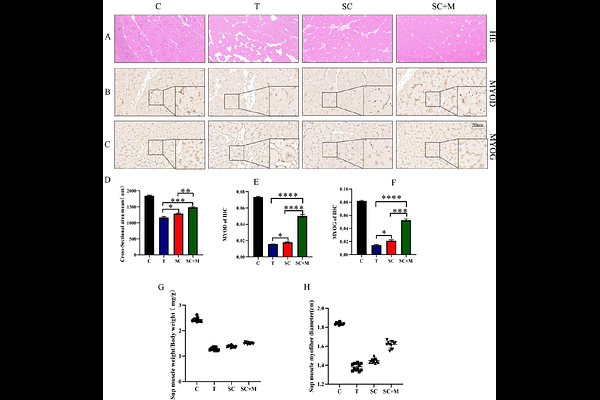Effect and Mechanism Analysis of Melittin on Promoting Muscle Differentiation of Adipose Stem Cells

Effect and Mechanism Analysis of Melittin on Promoting Muscle Differentiation of Adipose Stem Cells
Fei, W.-Y.; Li, M.; Yang, Y.; Zhang, J.
AbstractObjective: Melittin, the main peptide component of bee venom, exhibits anti - inflammatory, anti - cancer, and other biological activities. It has been shown to enhance the expression of muscle differentiation - related factors in mice, but whether it can promote myogenic differentiation of stem cells for treating skeletal muscle atrophy remains unclear. Adipose - derived mesenchymal stem cells (ADSCs) have great potential in muscle atrophy treatment due to their abundant source and excellent differentiation capacity. This study aimed to investigate if melittin could induce myogenic differentiation of ADSCs and improve skeletal muscle atrophy when combined with ADSCs. Methods: ADSCs were treated with melittin at 4 concentration ranges (0.02 - 320 mg/L) for 48 h, and cell viability was detected by CCK - 8. Western blot was used to measure the expression of myogenic factors (MYOG, MYF5, etc.) and p38 - MAPK pathway proteins. A mouse model of rotator cuff injury was established, with groups including control, injury, stem cell therapy (SC), and melittin combined with SC (SC + M). Muscle repair was evaluated by H&E staining, immunohistochemistry, etc. Results: Suitable melittin concentrations showed no toxicity to ADSCs but significantly upregulated myogenic factors. The SC + M group exhibited higher expression of MYOD and MYOG, and significantly improved muscle weight, fiber diameter, and cross - sectional area compared with the SC group. Mechanistically, melittin promoted myogenic differentiation by activating the p38 - MAPK signaling pathway. Conclusion: Melittin promotes myogenic differentiation of ADSCs via the p38 - MAPK pathway. Melittin - treated ADSCs show superior efficacy in muscle repair than single stem cell therapy, providing a potential strategy for skeletal muscle atrophy.